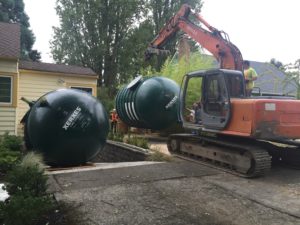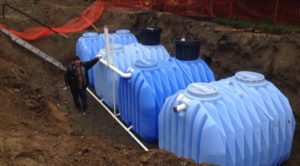 RainBank is experiencing increased interest in underground storage for our Seattle customers, requiring special considerations for underground water storage tanks.
RainBank is experiencing increased interest in underground storage for our Seattle customers, requiring special considerations for underground water storage tanks.
Aesthetics and available space are the most common reasons from these customers. Many are building larger homes on small lots that once had a 1,200 square foot home with a front and back yard. New construction is trending towards a larger footprint, leaving less room for water storage tanks. Slimline tanks allow for less visual impact, but are restrictive on volume. Other residents are remodeling older existing homes that still have yard space available – and are looking for greater amounts of storage. Below grade storage can be the answer, leaving a yard area that can accept landscaping right over the top of the water tanks.
Here are some things to consider with underground storage.
- First and foremost – costs. Below grade storage will require excavation and. most likely, exporting much of that soil, which would have to be loaded and trucked off site.
- Drainage needs to taken in account, with the new City of Seattle stormwater rules preferring infiltration for overflow. Where infiltration is not feasible, connection to the city storm system can be implemented for overflow as long as caution is taken to prevent sewer gases or back flow from entering the tank.
- Water tanks need to be properly vented and have a riser to access the tank for periodic cleaning and pump service. The installer must be sure that plumbing will not be compromised with slight settling or shifting of the tank.
- Below grade tanks tend to be more expensive to meet engineering requirements of underground tanks, and once installed, are considered a confined space and caution must be taken if access is necessary.
 For those who understand the considerations of underground storage, you have the luxury of landscaping that is free of visual impact and have different available options in tank sizes, styles, and materials. Tanks can be single or multiple, plastic or fiberglass. Cement tanks can be used for non potable use or lined with a NSF certificate for drinking water.
For those who understand the considerations of underground storage, you have the luxury of landscaping that is free of visual impact and have different available options in tank sizes, styles, and materials. Tanks can be single or multiple, plastic or fiberglass. Cement tanks can be used for non potable use or lined with a NSF certificate for drinking water.


My dad has been talking about putting a water tank in his backyard so that he always has access to water. He isn’t sure if he would like to put it underground or leave it above ground. I like that you point out that putting the tank underground comes at a price of having to pay for the soil to be exported. I’ll have to remind him of this the next time I see him.
Thanks for your comment about how slimline tanks come in many different materials and sizes. I didn’t know that a benefit of using them is that they don’t have much visual impact. If someone is considering getting slimline tanks, I would assume that they would remember this post.
I really like that you mentioned that below grade tanks tend to be more expensive. That’s a question my wife and I had prior to reading this article. We’d really like to have a water tank installed, and an underground water tank seemed like the best option. Being that we don’t have to worry about any of the considerations listed here, I think it would be a great option for our home. Thanks for the information!